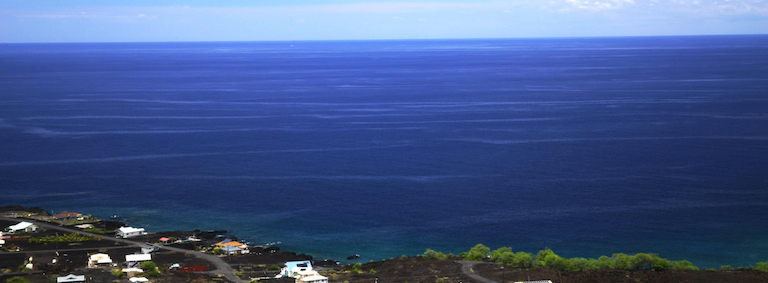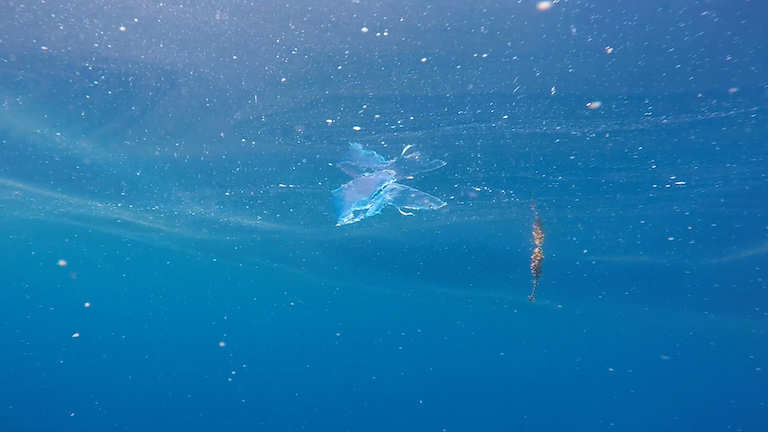- A new study found that surface slicks — moving patches of smooth water that form on the sea’s surface — host an array of species in larval form off the west coast of Hawaiʻi Island.
- The researchers identified more than 100 fish species from 54 families inside these slicks, representing 10% of all fish species ever recorded in Hawaiian waters.
- Surface slicks play a pivotal role in the marine ecosystem by providing food and shelter for larvae, and transporting them into different parts of the ocean.
- In addition to larvae, surface slicks accumulate large quantities of plastic, which has been found to be infiltrating the food chain.
In some parts of Hawaiʻi, the ocean is a blue canvas streaked with light-hued threads that curve and meander across the surface. These threads, called “surface slicks” or “bio slicks,” are often formed by underwater or internal waves, but they can also be shaped by other phenomena such as tidal and headland fronts. While sea slicks are ephemeral, lasting anywhere from an hour to a few days, researchers have found that they hold an astounding array of life, from eggs to baby fish to zooplankton larvae.
In a new study published in Scientific Reports, a team of international researchers dipped beneath the surface of these slicks off the western coast of Hawaiʻi’s main island to find out what secrets they envelop. Sea slicks only occupied about 8% of their 1,000-square-kilometer (386-square-mile) research area, but the slicks held about 39% of the region’s surface-dwelling larval fish, 26% of zooplankton, and 75% of floating organic debris, such as feathers and leaves, according to the study.
The amount of life inside these slicks was found to be so high, the researchers referred to them as “nurseries.”

“If you’re a boater and you’ve been out in the water, you go over [sea slicks] and you don’t think anything of them — but there’s a rich community just right there,” lead author Jonathan Whitney, a research marine ecologist for NOAA, told Mongabay in an interview. “Literally, most of these animals are right underneath the surface, but they’re so small that you can’t see them, so it really is a world that is just beyond view.”
The researchers found larval fish from 54 different families and more than 100 species inside these surface slicks. What’s more, these fish represented nearly 10% of all fish species recorded around Hawaiʻi, according to the study. The fish came from a variety of ocean habitats — from coral reef systems to the open ocean to the deep sea.
The most abundant fish in the slicks were flying fish (family Exocoetidae), known for their ability to leap several feet above the water as they travel long distances across the open ocean. There were also larval forms of triggerfish (family Balistidae) and blennies (order Blenniiformes), which help maintain Hawaiʻi’s reefs by scraping algae from coral, and also larvae from commercially fished species like mahi-mahi (Coryphaena hippurus), swordfish (Xiphias gladius) and marlin (family Istiophoridae). The slicks were also found to contain larvae from different species of lanternfish (family Myctophidae), bioluminescent fish that spend most of their lives in the mesopelagic zone, far from the sun’s rays.

“There’s some unique things in their findings,” Michael Kingsford, distinguished professor of marine biology at James Cook University in Australia and a surface slick expert, who was not involved in this study, told Mongabay in an interview. “Lanternfish are deep sea fish. Why might they [larval lanternfish] be coming up? Good question.
“To me, part of this paper is actually targeting opportunity,” Kingford added. “When people look at this, they might say, ‘Oh, there’s real opportunities to look at lanternfish here, for example.’”
Overall, the slicks were found to have 2.2 times more taxonomic richness than ambient waters, according to the study.
“We thought we would find things based on what we saw in the literature, but the density and the diversity of life that we found was … really impressive,” Whitney said. “The really shocking part was [that] we get a mixture of coral reef as well as open ocean species, and even animals that as adults are living at the bottom of the deep sea, but their larvae are coming up to the surface for the first month or so of their lives.”

While some species in early larval stages naturally will accumulate in these slicks, others will deliberately target the slicks to seek shelter in the floating debris or take advantage of the large diversity of prey, the study says.
“Slicks concentrate food and shelter for developing larvae, potentially increasing survival rates and bolstering recruitment of young fish and invertebrates, which are important to humans for fisheries, recreation, and other ecosystem services,” the researchers write. “By providing these survival advantages, surface slicks enhance larval supply and thus replenishment of adult populations in coral reef, epipelagic, and deep-water ecosystems.”
The paper suggests that surface slicks have far-reaching impacts on coastal ecosystems by acting as a nexus in the marine food web and larval supply, and by transporting larvae into different parts of the ocean where they develop into juveniles and adults.
“Our findings are part of an important story forming around the role of biological surface slicks in maintaining coral reefs,” co-author Greg Asner, director of the Center for Global Discovery and Conservation Science at Arizona State University (ASU), said in a statement. “The sheer biodiversity and biomass of the slicks, combined with their oceanic movement along the shore, form a superhighway for species that connects and effectively generates an interconnected, regional reef ecosystem.”

The research team obtained data through 130 plankton tows in both surface slicks and nearby ambient waters. They also used satellite-based maps to help determine where the slicks were in the ocean.
The study also highlights a widespread issue with plastic pollution. In an earlier study co-authored by Whitner, Asner and other researchers, plastic was found to accumulate in surface slicks, outnumbering larval fish by 7 to 1. The new study in Scientific Reports also notes the high density of plastic, which comprised more than 61% of all floating debris.
“We thought that because they [surface slicks] accumulate buoyant things that we would find plastic, but we were not prepared for how much plastic we’d find,” Whitney said. “They are really good at compressing and accumulating these buoyant floating plastics. I think that the biggest density was 37,000 pieces in a single seven-minute tow.”
Some of the plastics were the “size of grains of sand” or were tiny microfibers difficult to see with the naked eye, Whitney said. When the team dissected some of the larval species found in the surface slicks, they discovered microplastic particles in nearly 10% of them, he said.

The abundance of life held within these surface slicks raises a probing question about boating: should vessels be permitted to drive over these slicks? Whitney said there’s no official perspective on this in Hawaiʻi, but that he personally tries to avoid them.
“Once we found everything that was in there, we were like, ‘We need to stop driving over these things,” Whitney said. “Now we try to avoid them whenever we’re out in the water because there’s just a lot of stuff there that is really small and fragile.”
Kingsford, who has written about surface slicks since the 1980s, says he’s pleased to see that surface slicks are being studied more extensively, adding that he hopes there will be more research on these features. For instance, he said it would be interesting to know what happens inside these slicks during the night.
“It’s nice to see progress in the field,” he said. “Various people, like myself, have pointed out that they [surface slicks] are very interesting oceanographic features that have consequences for plankton and small fish and larger things like dolphin fish [mahi-mahi]. But what he’s [Whitney’s] done is advanced it to …. large areas of ocean, which gives you a much … broader geographic view of the likely role of these particular things. And he’s showing just how critical they are [across] broad spatial scales, which I think’s an update on some of the previous work.”
Citations:
Whitney, J. L., Gove, J. M., McManus, M. A., Smith, K. A., Lecky, J., Neubauer, P., … Asner, G. P. (2021). Surface slicks are pelagic nurseries for diverse ocean fauna. Scientific Reports, 11(1), 3197. doi:10.1038/s41598-021-81407-0
Foo, S. A., Walsh, W. J., Lecky, J., Marcoux, S., & Asner, G. P. (2020). Impacts of pollution, fishing pressure, and reef rugosity on resource fish biomass in west Hawai‘i. Ecological Applications. doi:10.1002/eap.2213
Gove, J. M., Whitney, J. L., McManus, M. A., Lecky, J., Carvalho, F. C., Lynch, J. M., … Williams, G. J. (2019). Prey-size plastics are invading larval fish nurseries. Proceedings of the National Academy of Sciences, 116(48), 24143-24149. doi:10.1073/pnas.1907496116
Banner image caption: Composite image showing examples of the remarkable diversity of larval and juvenile fishes and invertebrates found living in surface slick nurseries along West Hawai’i Island. Larval photos by Jonathan Whitney (NOAA Fisheries) / Surface slicks photo by Joey Lecky (NOAA Fisheries).
Elizabeth Claire Alberts is a staff writer for Mongabay. Follow her on Twitter @ECAlberts.
FEEDBACK: Use this form to send a message to the author of this post. If you want to post a public comment, you can do that at the bottom of the page.
The Link LonkMarch 23, 2021 at 03:29AM
https://ift.tt/3sbatL2
On the sea's surface, a wealth of ocean life gets its start, study finds - Mongabay.com
https://ift.tt/2CoSmg4
Sea
/cloudfront-us-east-2.images.arcpublishing.com/reuters/CZF6NULMVVMEXHOP7JK5BSPQUM.jpg)
No comments:
Post a Comment